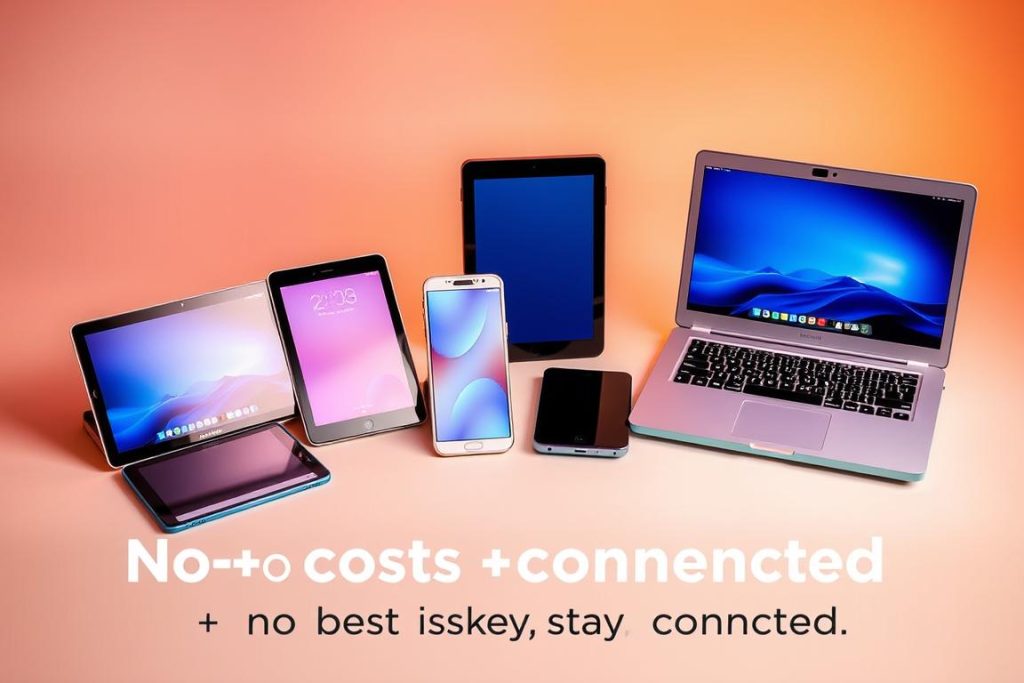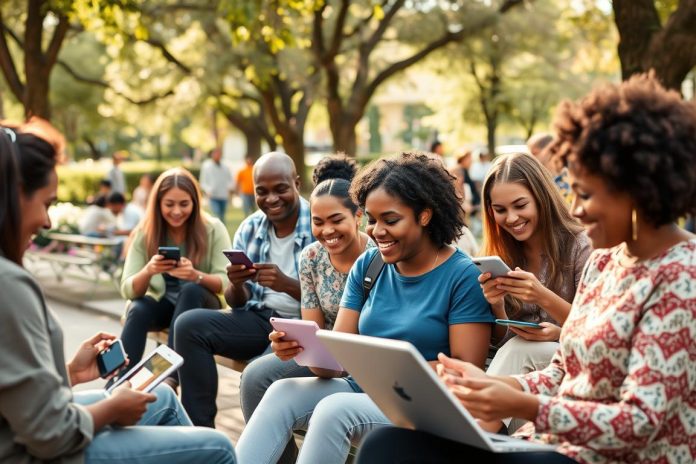Did you know about 50 million American families find it hard to pay for basic things like phone bills? This huge number shows how necessary it is to have cheap and reliable ways to communicate. Since the Affordable Connectivity Program (ACP) has been put on hold, many families with little money need other options to keep in touch.
Luckily, some trusted groups are helping out. Free Phone Wireless is a non-profit doing great work in this area. They make sure people who qualify can get free devices like the iPhone 7 and Galaxy S9. They don’t have to deal with costly monthly bills. Apart from phones, they also give out tablets and internet services. These come with extra benefits like free unlimited data, talk, and text for those who are eligible. Such programs are aimed at closing the tech gap and showing how crucial it is to have access to the latest tech in our daily lives.
Companies like Assurance Wireless, SafeLink Wireless, and AirTalk Wireless are offering free gadgets and technology. This makes the digital world more reachable for those who really need it. Thanks to these efforts, everyone can stay connected and enjoy the great things communication tech offers.
Key Takeaways
- Around 50 million American households struggle to afford basic needs, including phone bills.
- Free Phone Wireless offers gratis devices like iPhone 7 and Galaxy S9 with no monthly costs.
- Programs such as Lifeline and ACP previously ensured access to technology for low-income families.
- Providers including SafeLink Wireless and Assurance Wireless provide free tech products without hidden fees.
- Eligibility typically depends on income level or participation in federal aid programs like Medicaid or SNAP.
- Efforts are directed to bridge the digital divide and ensure everyone stays connected.
- Both phones and tablets are available, along with free unlimited data, talk, and text plans.
Understanding the Need for No-Cost Technology
The Affordable Connectivity Program (ACP) ending means over 23 million households lose broadband bill discounts. This is especially hard for those in rural areas with few internet choices. It shows how vital technology access is today. It helps students do homework online, adults use telemedicine, and small businesses operate.
The Impact of the ACP’s End on Low-Income Households
Ending the ACP hits low-income families hard. They relied on these subsidies to afford the internet. Without free devices or no-cost tech, staying connected becomes a challenge. In many poorer areas, only 5-15% can get the assistive devices they need. This fact shows the urgent need to keep such tools available.
Alternative Government Programs and Benefits
Even with the ACP gone, other government benefit programs help those in need. For example, TruConnect’s role in the Lifeline program offers internet discounts and devices. Plus, places like Community Based Rehabilitation Biratnagar in Nepal help people with disabilities by providing services and assistive devices.
These efforts show the need to make free tech widely available. Exploring these options can help keep us connected. It’s important to use these resources to our advantage.
Get Free Devices through Trusted Organizations
Nowadays, getting free gadgets is easy, thanks to certain organizations. This section will show you where to find these offers. They help students stay online without spending a lot. It’s all about keeping connected affordably.
List of Available Free Phones and Tablets
Groups like StandUp Wireless and TruConnect give out free phones and tablets. They include brands like Apple and Samsung. So, you get to enjoy the newest tech without cost. Let’s look at these providers more closely:
- StandUp Wireless: Offers smartphones with touchscreens, cameras, and robust internet connectivity.
- TruConnect: Provides both phones and tablets that support internet browsing, email access, and pre-installed apps.
- Entouch Wireless: Features affordable devices aimed at optimizing your connectivity needs.
- Qlink Wireless: Known for a wide variety of cost-free gadgets that cater to diverse consumer preferences.
- Airtalk Wireless: Offers a range of complimentary devices, facilitating seamless connectivity.

How to Qualify for No-Cost Tech Devices
Want a free device? You might need to join programs like Medicaid or SNAP. Your income must be below 135% of the Federal Poverty Guidelines. Remember, only one person per household can get a free device. This helps make sure everyone gets fair access.
Looking for internet? The Lifeline or Affordable Connectivity Programs (ACP) could be your ticket to free tech. Here’s a quick look at some internet options:
| Internet Service Provider | Program | Cost | Speed |
|---|---|---|---|
| Xfinity | Internet Essentials Plus | $29.95/month | Up to 100Mbps |
| AT&T | Access Program | No Cost | Up to 100Mbps |
| Cox | ConnectAssist | $30/month | Up to 100Mbps |
| Synergy Internet | Federal Grants | Varies | Varies |
Free Device Programs for Students
Students need gadgets for school. That’s why T-Mobile started Project 10Million. It gives students hotspots and data for schoolwork. This and other programs ensure students have the tech they need for success.
Such efforts provide not just gadgets, but also stable internet. They aim to make sure all students have the same chances to learn and grow.
Conclusion
Getting free electronics can help close the digital gap caused by the end of the ACP program. This effort is key to making sure low-income people stay online. Since cell phones first appeared in 1973, they’ve come a long way, now doing so much more than just making calls.
Finding and getting free gadgets may look hard, but groups like Lifeline and Free Phone Wireless make it possible. These groups don’t just give out gadgets. They also open doors to staying in touch with school, jobs, and friends. Talks on this subject might lead to action, encouraging folks to join together and grab these chances. Strategies like calls to action could be used.
Today’s tech and new government programs strive to ensure everyone has the digital tools they need. This effort includes special programs for students and wider plans for all. By embracing new technologies and energy solutions, we can build a digitally fair world. It means everyone gets the tools they need to keep up, participate, and stay informed.

